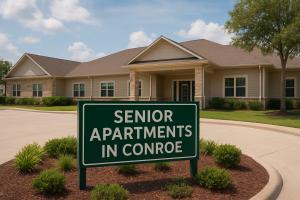Growing Dementia Cases Boost Demand for Senior Housing in Texas
Village Green Expands in Conroe, Kingwood & Champions, TX to Provide Senior Living, Respite Care, and Specialized Memory Support for Every Stage of Aging.
CONROE, KINGWOOD, AND CHAMPIONS, TX, UNITED STATES, August 15, 2025 /EINPresswire.com/ -- In light of demographic shifts and an increasing incidence of cognitive impairment among older adults, Village Green Memory Care Community has undertaken a regional expansion strategy designed to serve a diverse range of care needs. The effort focuses on three distinct yet interconnected service types: senior apartments in Conroe, respite care homes for dementia in Kingwood, and memory care facilities in Champions, TX. This tri-regional framework is intended to accommodate aging individuals at different stages, from independent living to short-term relief for caregivers to specialized, full-time dementia care, while emphasizing stability, continuity, and compassionate residential support.Regional Demographics and the Context for Care Expansion
Both Montgomery and Harris Counties are experiencing a marked increase in the population aged 65 and older. U.S. Census projections suggest a rise of more than 25% in seniors over the next decade, with growth concentrated in suburban enclaves such as Conroe, Kingwood, and Champions. Simultaneously, Alzheimer’s disease and related dementias are becoming more prevalent, placing strain not only on healthcare systems but also on family caregivers attempting to provide consistent home-based support.
These trends highlight a growing need for flexible, community-based residential care solutions. There is increasing demand for housing options that accommodate retained independence, temporary relief solutions tailored to dementia caregiving, and long-term, memory-centered living environments. Addressing broad needs within a single organization allows residents to benefit from structured continuity, gradually adapting to increased care needs over time without being displaced.
1. Senior Apartments in Conroe: Independence with Strategic Support
As demand for accessible housing increases, senior apartments in Conroe are emerging as an effective bridge between independent living and care-intensive environments. These residences are designed with architectural accessibility in mind, single-floor layouts, wide doorways, and features that accommodate reduced mobility. Social areas, communal amenities, and optional wellness or leisure activities help cultivate resident engagement, while light touch oversight (e.g., wellness check-ins, housekeeping support, optional meal services) balances autonomy with oversight.
Will staff regularly monitor resident well-being, they do so unobtrusively, enabling aging individuals to retain their routines and sense of privacy. This living model aligns with modern “aging in place” philosophies, aiming to delay transitions into higher levels of care while responding to emerging cognitive or physical changes. Some units are equipped with adaptable features (e.g., motion sensors, automated medication reminders) that enable early identification of changes in resident behavior or health, prompting assessments and care adjustments as needed.
With longer life expectancy and earlier onset of dementia symptoms, an environment that can adapt, rather than force relocation, serves both individual residents and their families. The design philosophy behind these apartments acknowledges that most cognitive decline unfolds gradually; thus, a flexible residential setting enhances quality of life while forestalling disruptive transitions.
2. Respite Care Homes for Dementia in Kingwood: Alleviating Caregiver Burden
In Kingwood, home-based caregiving remains prevalent, but the emotional and physical demands are growing. This has prompted the opening of respite care homes for dementia, which provide structured, temporary relief for caregivers while ensuring patient safety, routine, and well-being.
These facilities offer short-term stays that typically range from days to several weeks, accommodating situations such as caregiver illness, scheduled travel, or transitional health events. Staffing includes dementia-trained caregivers who assist with daily activities like bathing, dressing, meals, and engaging programming. Importantly, the environment mirrors the resident’s routines, set meal times, familiar sensory cues, and supportive structure to minimize confusion and maintain cognitive stability.
Beyond physical supervision, respite care homes support caregiver well-being by providing much-needed rest, emotional reprieve, or flexibility in managing personal appointments. At the same time, families can observe and evaluate facility services, onset of symptoms, or progression of cognitive decline, informing potential planning for long-term care placements with greater clarity.
This form of short-term dementia-specific housing is essential for reducing emergency placements, delaying institutionalization, and enabling caregivers to recharge without compromising resident safety or routine. The respite model therefore fills a critical gap by offering flexibility, continuity, and time-sensitive lodging solutions for families navigating evolving dementia care.
3. Memory Care Facilities in Champions, TX: Secure Support for Progressive Decline
In Champions, there is high demand for residential environments tailored to moderate and advanced dementia care. This demand is met through memory care facilities in Champions, TX, which deliver secure, person-centered residential settings designed to promote safety, cognitive engagement, and behavioral support.
Facility design prioritizes physical safety, enclosed outdoor areas, restricted access points, intuitive wayfinding, and simplified layouts reduce risks of wandering and disorientation. Programming centers on evidence-based activities: music therapy, reminiscence-based sessions, sensory stimulation programs, and adaptive exercise routines. Daily schedules are structured and predictable, offering familiar cues through repeated routines that support cognitive anchoring.
Staff teams in these facilities are trained in non-pharmacologic intervention techniques, de-escalation strategies, and compassionate communication methods. They develop individualized care plans informed by ongoing cognitive assessments, medical coordination, and behavioral observation. These plans are dynamically updated to reflect transitions in resident needs, with adaptations in environmental support, activity engagement, and clinical monitoring as required.
By housing individuals with behavioral vulnerabilities in thoughtfully designed and staffed environments, these facilities provide safety, emotional stability, and cognitive stimulation, without relying primarily on institutional medicalization. They offer an intermediate residential option that avoids clinical sterility, yet addresses the complexity of advanced dementia.
4. Connecting the Continuum: Regional Integration and Care Coordination
Although each care setting serves a different stage of independent stability, short-term relief, and full-time memory support, they function within a broader continuum when a focus on structured transitions and service alignment is applied.
Residents in senior apartments in Conroe might experience early cognitive decline, noted through wellness monitoring or caregiver feedback. If so, coordinated assessments can facilitate transitions either to short-term placements in Kingwood’s respite care or, if appropriate, direct transition to memory care facilities in Champions. The goal remains to minimize disruption and maintain environmental consistency while adjusting care appropriately.
Similarly, families utilizing respite care in Kingwood receive case management guidance and, as necessary, transition planning for long-term placement. Records, care profiles, and medical histories are shared among providers within this network to preserve continuity and minimize redundancy. This structure is especially crucial in dementia care, where disrupted routines or changes in staff can significantly impact resident cognition and emotional well-being.
For families, the advantage lies in transparent coordination, shared records, unified intake processes, and centralized care oversight, creating a smoother, less stressful path through increasing care needs.
5. Supporting Caregiver Engagement and Education
Caregiver stress is a common and persistent issue, especially for families managing dementia. In each service area Conroe, Kingwood, and Champions support mechanisms are embedded to strengthen caregiving capabilities and emotional resilience.
These include:
· Educational workshops on dementia progression and caregiving techniques
· Guidance on legal matters such as power of attorney and advance healthcare planning
· Support groups or peer networks for exchanging experiences
· Resource navigation for coverage options like Medicare, Medicaid, or veterans' benefits
Access to reliable information and personal support empowers caregivers to make informed choices, elevates trust in the system, and ultimately improves outcomes for both residents and families. This approach shifts the caregiving experience from crisis-driven management to a more sustained and informed process.
6. Addressing Clinical Complexity Through Interdisciplinary Care
Cognitive impairment rarely exists in isolation. Older adults may manage multiple chronic conditions, diabetes, heart disease, mobility limitations alongside dementia.
Across the residential models, interdisciplinary care teams are critical:
· Nursing staff monitor vital signs, assist with medication and mobility
· Dietitians coordinate nutritional interventions and food preferences
· Physical, occupational, and recreational therapists support mobility, engagement, and sensory activation
· Behavioral specialists guide non-pharmacologic behavioral interventions
Regular assessments help teams update individualized care plans, modify environmental supports, and align therapeutic programming with resident needs. This integrated model ensures mental and physical health remain coordinated, with preventive strategies designed to delay functional decline and reduce hospital readmissions.
7. Aligning with Future Trends and Innovation in Dementia Care
Texas is on course to face escalating demand for dementia-supportive services as the aging population increases. To meet this trajectory, service models are evolving toward the following innovations:
· Technology-assisted monitoring – wearable devices for fall detection and medication reminders
· Telehealth integration – remote cognitive assessments, geriatric consultations, and behavioral support
· Hybrid care facilities – combining assisted living and memory care within unified campuses for flexibility
· Culturally competent programming – culturally relevant therapies, language-specific staff, and dietary accommodations
· Access equity – partnerships with public and nonprofit funders to support under-resourced families or Medicaid recipients
These innovations extend the capacity and responsiveness of regional memory care, helping communities prepare for growing clinical complexity while promoting dignity and access.
Summary
Across Conroe, Kingwood, and Champions, three distinct residential care models are now integrated into a continuum serving older adults at different stages of cognitive and functional ability:
· Senior apartments in Conroe supporting independence with scalable assistance
· Respite care homes for dementia in Kingwood providing structured short-term relief to caregivers
· Memory care facilities in Champions, TX, offer specialized long-term environments for advanced dementia care
These services are connected through coordinated assessment, shared care planning, family education, and unified documentation. By enabling gradual transitions, emphasizing clinical coordination, and addressing emotional and caregiver needs, the framework serves as a replicable example of regionally integrated dementia care.
About Village Green Memory Care Community
Village Green Memory Care Community develops and manages continuity-driven residential services across Southeast Texas, tailored to support aging individuals with cognitive impairment through well-designed living environments, therapeutic programming, and family-centered planning. Its offerings, including senior apartments, respite housing, and memory care, are structured to promote stability, dignity, and adaptable support at every stage of the dementia care continuum.
Zahra Sabir
Village Green Alzheimers Care
+1 281-208-5876
info@villagegreenalzheimerscare.com
Visit us on social media:
LinkedIn
Instagram
Facebook
Legal Disclaimer:
EIN Presswire provides this news content "as is" without warranty of any kind. We do not accept any responsibility or liability for the accuracy, content, images, videos, licenses, completeness, legality, or reliability of the information contained in this article. If you have any complaints or copyright issues related to this article, kindly contact the author above.





